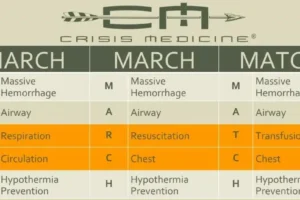
Old and Still Relevant: 1913 First Aid Cards
- Posted by Mike Shertz MD/18D
- Categories MARCH, More
Advertising to educate the public in basic first aid techniques
🕖 Reading Time, 6 minutes
Cards like these were included in packs of cigarettes made by the Imperial Tobacco Company. Often referred to as ‘Wills cards,’ issued by WD and MO Wills, Bristol and London. Informational cards like these first appeared in 1913.
Early mass-produced cigarettes were sold in flimsy paper wrapping and the cigarettes were often damaged before they could be smoked. This led to companies adding a cardboard “stiffener” to the packs to help protect the cigarettes. The early versions of these cards were colorful advertisements and date back to 1879.
As the card styles progressed, many different topics appeared, from military progress during the Boer war, historic events, and “flags of all nations.” Since newspapers at the time didn’t include pictures, these cards were viewed as a bit of escapism and representation of the world. Eventually, men, women, and children began collecting them (usually by buying the products to get them). As such they had to be colorful and interesting enough to get the consumer to collect the entire set. By the 1930s leading companies were printing up to 40 million copies of each card.
This set demonstrated first aid techniques for use in an emergency. Some say they were meant to be stored in the “medicine chest” as part of a first aid kit.
Although the improvised “stick rag” tourniquet has been vilified as not working, if the cravat around the limb is several inches wide and the windlass or twist stick doesn’t break, the technique has been shown to be reasonably effective. This has been shown across several different testing models from the HapMed tourniquet trainer (a very flawed model, but that’s what the USAISR frequently uses) to doppler ultrasound on volunteers, and actual casualties.
A well-designed commercial tourniquet should be more effective than this improvised technique, but in a mass casualty incident, or if you run out of dedicated medical equipment you need a plan for what’s next.
The second card shows how to fold a piece of fabric into a “triangular” bandage or cravat for use as a sling or improvised tourniquet.
This card shows the location of major arteries in the body. It provides arrows where the arteries are close enough to the surface that direct pressure on the artery might occlude it. This concept of “pressure points” was taught for a very long time.
Unfortunately, some arteries run in parallel like in the forearm and leg. Occluding one, just results in flow past the pressure point because of the “collateral” circulation. However, some arteries, like the brachial in the arm and femoral in the groin below the inguinal ligament / crease are amenable to direct pressure for occlusion.
Often foreign bodies get trapped under the upper lid and scratch across the surface of the eye with every blink. Looking for foreign bodies under the lower lid is easy: all you have to do is retract the lid and look. This simple technique to flip an upper eye lid ”inside out” allows you to look under it as well for a foreign body. Then it can be removed with water irrigation or even a moistened cotton swab. …I’m not certain about putting castor oil into the eye. Maybe we’ll ignore that part.
This improvised litter technique using two shirts buttoned or zipped up the front with the sleeves routed through the shirt, followed by poles or 2x4s through the sleeves is still in the current US Army training circular TC 4-02.1 First Aid as an option. The technique works quite well, but finding something to use as the poles is always the rate limiting step.
This card depicts how to perform the fireman’s carry of a casualty. Though still in the US Army training circular TC 4-02.1 First Aid, it was long since abandoned by firefighters because of its association with low back injures of the individual doing the carrying.
Although a good single carry technique, carriers often twist at their waist trying to get under and beneath the casualty’s legs. This results in bad lifting ergonomics and subsequent low back injury.
WANT TO LEARN MORE? ONLINE CLASSES.
Dr. Mike Shertz is the Owner and Lead Instructor at Crisis Medicine. Dr. Shertz is a dual-boarded Emergency Medicine and EMS physician, having spent over 30 years gaining the experience and insight to create and provide his comprehensive, science-informed, training to better prepare everyday citizens, law enforcement, EMS, and the military to manage casualties and wounded in high-risk environments. Drawing on his prior experience as an Army Special Forces medic (18D), two decades as an armed, embedded tactical medic on a regional SWAT team, and as a Fire Service and EMS medical director.
Using a combination of current and historical events, Dr. Shertz’s lectures include relevant, illustrative photos, as well as hands-on demonstrations to demystify the how, why, when to use each emergency medical procedure you need to become a Force Multiplier for Good.














